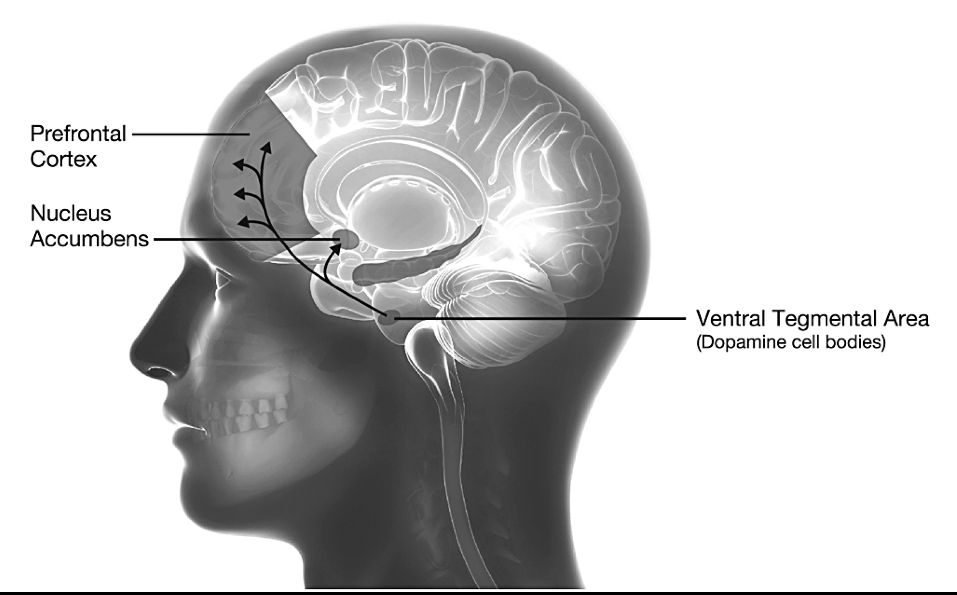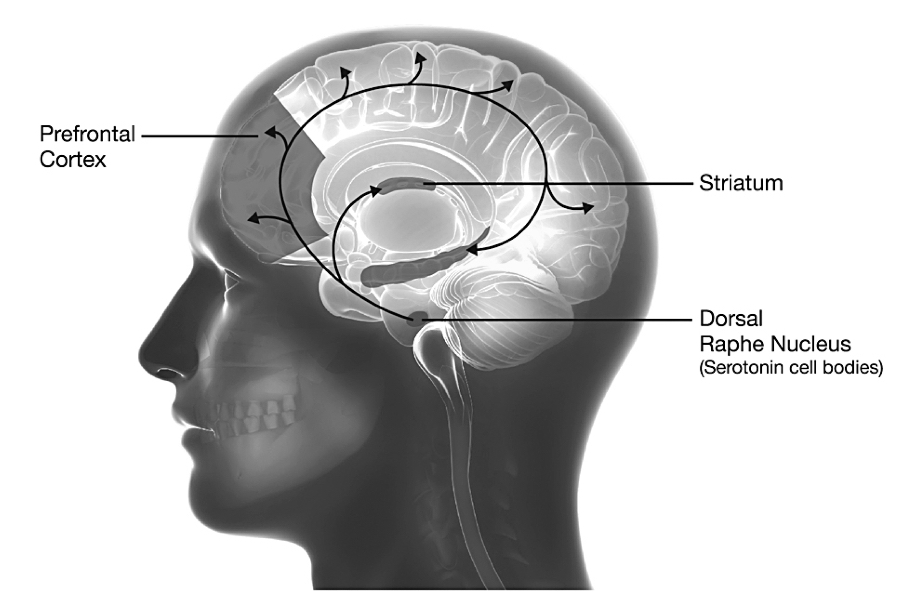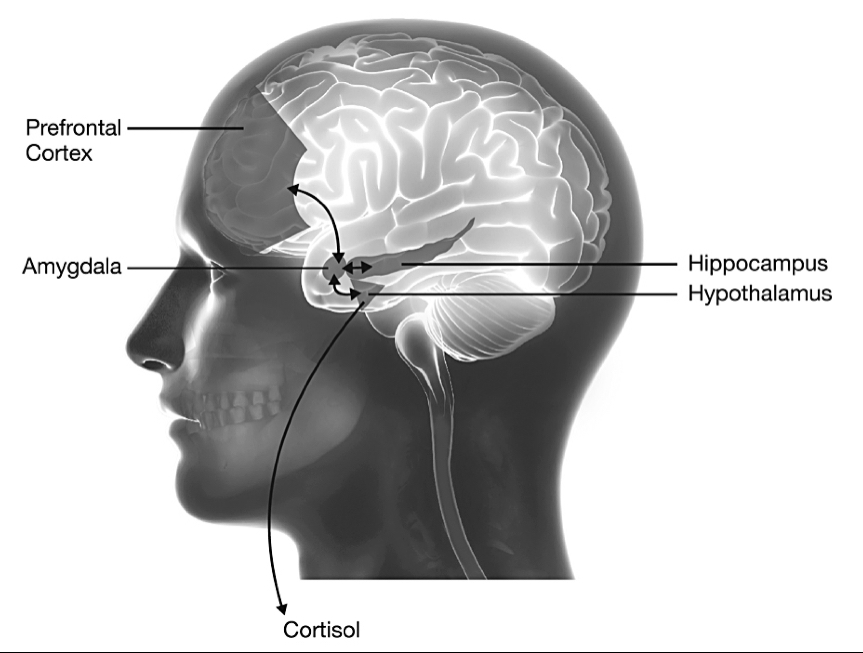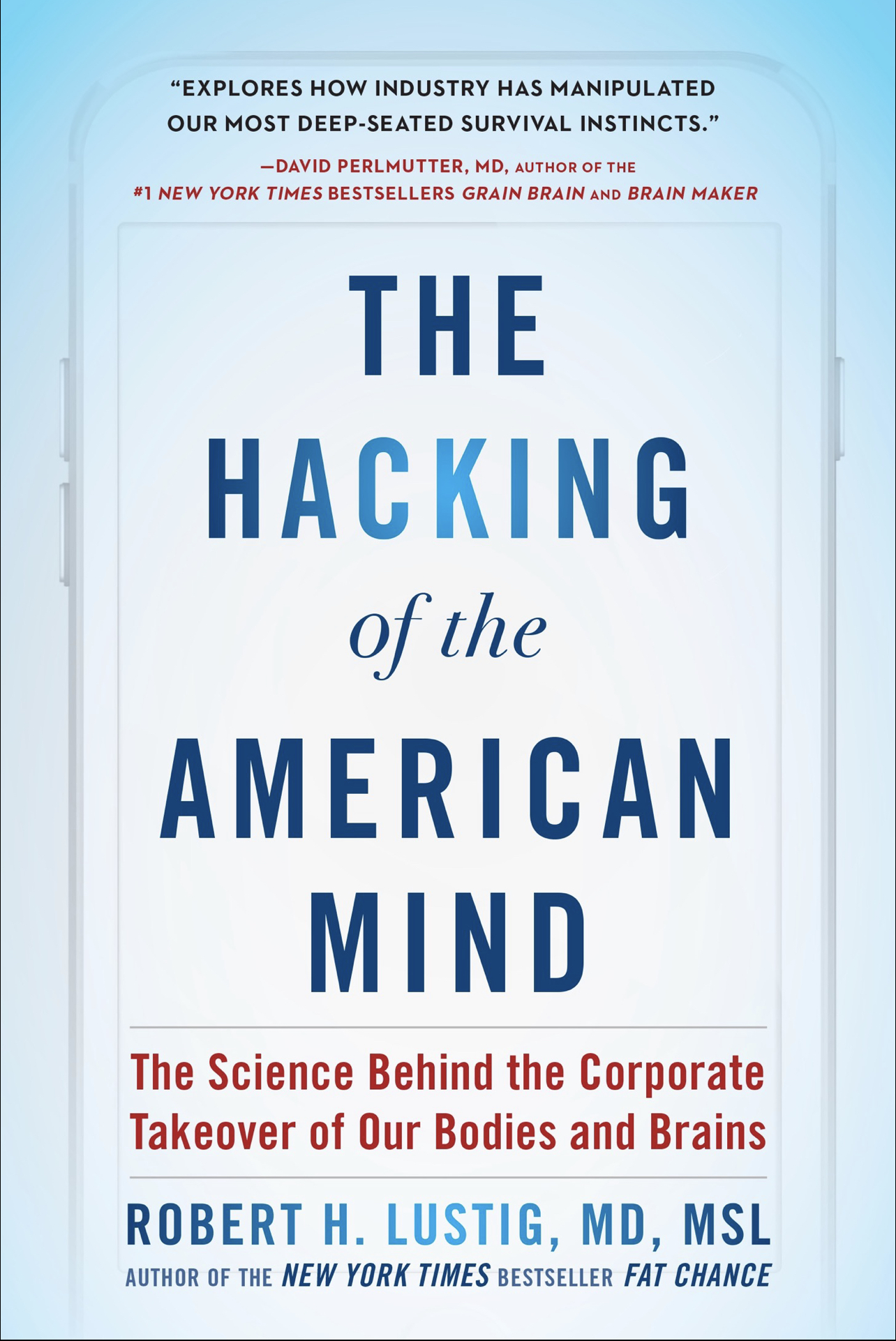← The Hacking of the American Mind The Science Behind the Corporate Takeover of Our Bodies and Brains
The Hacking of the American Mind The Science Behind the Corporate Takeover of Our Bodies and Brains Chapter 2. Looking for Love in All the Wrong Places
Author: Robert H. Lustig Publisher: New York, NY: Penguin Random House. Publish Date: 2017 Review Date: Status:📚
Annotations
Highlight(pink) - Location 408
Treating the result never works; it’s too late, the horse is out of the barn. Plus, treating the result just papers over the real problem: the cause is still there. Treating the cause works. But you have to understand the cause before you can treat
Highlight(pink) - Location 417
Each neuron has a cell body that makes proteins so the neuron can stay alive, and neurotransmitters that allow neurons to communicate with each other. They each have dendrites, which are special appendages that receive information, on which there a number of receptors. Neurotransmitters and receptors can be described as floating keys that fit into specific locks. Each neuron also has one long axon, a special fiber that transmits this information. When a neural impulse is generated in the first cell, it pulses down to the end of the axon, which contains little packets of neurotransmitters (the keys) waiting to be released. The firing axon then shoots the neurotransmitters across the synapse to bind to the receptors (the locks) on the dendrites of the next cell.
Highlight(pink) - Location 424
FIGURE 2: The brain’s limbic, or emotion regulation, system. The limbic system consists of three major pathways that send and receive chemical information that is translated into positive and negative emotions. The interplay between these three distinct pathways dictates both the perception of emotion and the resultant behavioral responses.
Note - Location 427

Highlight(pink) - Location 428
Fig. 2-1: The reward pathway utilizes the neurotransmitter dopamine to communicate between the neurons of the ventral tegmental area (VTA) and the dopamine receptors of the nucleus accumbens (NA) to generate the feelings of motivation that attend reward and learning.
Highlight(pink) - Location 430
(1) The first system, the “reward pathway” (Fig. 2-1), is made up of neurons (brain cells that send and receive information) that synthesize the neurotransmitter (chemical for communication) dopamine in a primitive (you don’t control it, it controls you) nucleus (collection of like-minded neurons) in the midbrain known as the ventral tegmental area (VTA). When neurons in the VTA fire, they send their dopamine to another brain area called the nucleus accumbens (NA) to generate the feelings of motivation that attend reward. The NA is also a “learning” pathway—learning what feels good (shopping, alcohol, masturbation). Those neurons then release a set of neurochemicals known as endogenous opioid peptides (EOPs), which have the same effects on the brain as morphine and heroin do, and which generate the feeling of pleasure or bliss.
Note - Location 437
Image

Highlight(pink) - Location 437
Fig. 2-2: The contentment pathway utilizes the neurotransmitter serotonin to communicate between neurons of the dorsal raphe nucleus (DRN) and multiple sites throughout the cerebral cortex, where the brain interprets impulses as “good” or “bad.”
Highlight(pink) - Location 439
(2) The second system is the “contentment pathway” (Fig. 2-2). A different primitive area in the midbrain called the dorsal raphe nucleus (DRN) contains neurons that produce serotonin and fan out to distant sites all over the cerebral cortex, the thinking part of the brain, where you process experiences and make judgments like “That’s good” or “That’s bad.”
Highlight(pink) - Location 442
Serotonin acts in different ways on different neurons, depending on each neuron’s function and the type of receptor (a specialized protein that receives and binds with the molecule, to alter the firing of the next neuron) that sits on its surface.
Note - Location 444

Highlight(pink) - Location 445
Fig. 2-3: The stress-fear-memory pathway consists of four areas. The amygdala, or your stress center, is in communication with the hypothalamus (at the base of the brain), which controls the stress hormone cortisol. The hippocampus, or your memory center, interprets memories as both good and bad. The amygdala and the hippocampus are reciprocal to each other. The fourth area is the prefrontal cortex (PFC); this is the wise area of the brain that inhibits behaviors that put you at risk. These four areas together keep your outward behavior in check.
Highlight(pink) - Location 449
(3) The third brain system is the “stress-fear-memory pathway” (Fig. 2-3). There are four areas of the brain involved in this pathway. The amygdala is your stress or fear center. It is a walnut-shaped area, one on either side of the brain. When you’re in a dark alley, your amygdala is going gangbusters.
Highlight(pink) - Location 451
amygdala is in communication with three other areas. The hypothalamus, at the base of the brain, controls all the hormones of your body, including the stress hormone cortisol, which prepares your body for extreme duress. It also sends messages to your sympathetic nervous system (the fight-or-flight response) to get ready and your vagus nerve (the vegging, chillaxing nerve that slows everything down) to stop firing. The hippocampus is your memory center. It’s where you lay down memories, both good and bad. The amygdala and the hippocampus are reciprocal in that when your amygdala figures out that an experience is not a good one, that information ends up stored in the hippocampus (“I’ve seen this movie before”). The pain of that hot stove from your childhood resides here, as does the last horror movie you saw. And finally the fourth area is the prefrontal cortex (PFC); this is the wise area of the brain that keeps you from doing stupid things again, like insulting your boss, or going to another horror movie. These four brain areas together keep your emotions from overwhelming your ability to think straight and your outward behavior in check.
Highlight(pink) - Location 460
These three pathways generate virtually all human emotion, and in particular those of reward and contentment. The motivation for reward is experienced when the dopamine signal reaches the NA. A host of different stimuli (power, gambling, shopping, internet, substances) generate signals of reward, but that internal feeling of reward is pretty much the same whatever the trigger. This is why virtually any stimulus that generates reward, when taken to the extreme, can also lead to addiction. You can get addicted to a drug, but you just as easily can get addicted to a behavior, such as gambling or internet use.
Highlight(pink) - Location 464
Conversely, while experiencing happiness is predicated upon sending the serotonin signal, the actual interpretation of that signal isn’t as simple. It also depends on the receptor that is receiving that signal, which changes how you experience it. This is why the positive emotions derived from listening to certain types of music have a different quality from the ones experienced when graduating from college, which are different from the ones triggered by building a home for Habitats for Humanity. And this is very likely why there are so many different definitions of happiness—many different on-ramps, many different roads, many different speed limits—but only one destination for contentment. Other positive emotional phenomena, such as joy, elation, rapture, and the mystical experience, likely take the same roads but end up taking different exits.
Highlight(pink) - Location 470
To convey the nature of, and the difference between, these two emotions of reward and contentment, and how these emotions have been hacked, I must first convince you that that these and other emotions are rooted in the workings of the brain. So let me now give you two examples of the power and scope of these three pathways on your emotional state, and how manipulating them either externally (using a drug) or internally (through a wayward passion) can take a simple positive emotion and turn it into a weapon of mass destruction. I offer you Exhibit A: rimonabant.
Highlight(pink) - Location 474
If it weren’t for reward or the promise of it, we’d all commit suicide due to deep and inconsolable misery. This hypothesis was put to the test a decade or so ago with the release in Europe of the anti-obesity drug rimonabant (Accomplia, Sanofi-Aventis). This medication looked extraordinarily promising right up to and through its approval for general use by the European Medicines Agency (the European equivalent of our FDA). The first endocannabinoid antagonist, rimonabant was the anti-marijuana drug. As it turns out, many of the brain pathways outlined above possess a receptor for tetrahydrocannabinol (THC), the active compound in marijuana. When THC binds to this receptor, known as the CB1 receptor, it heightens mood and alleviates anxiety, which partially explains why people become so giddy when they smoke pot; it also heightens the transduction of pleasure, which explains why so many pot smokers have sex after they partake; and it explains why people get the munchies afterward. Why would Mother Nature put a receptor for marijuana in our brains anyway? As it turns out, we make our own endogenous brain compound, called anandamide, which naturally binds to that CB1 receptor and which keeps us eating and renders most of us semi-functional in social groups, even if we’re not smoking pot. But in those who toke, anxiety is thrown to the wind along with every inhibition it suppresses, leaving plenty of room for pleasure.
Highlight(pink) - Location 484
Rimonabant blocks this CB1 “feel good–munchies receptor.” This drug was approved by the European Commission in 2006. As a weight-loss drug, it worked very well and mitigated the co-morbidities of obesity.1 The data were incontrovertible. Lots of people lost lots of weight. Their appetites went down and they stopped eating junk food. They lost all interest in food; it just didn’t provide pleasure anymore. In fact, they derived no pleasure from anything. Rather, their anxiety increased markedly. For five years prior to approval, rimonabant was all anyone in the obesity field could talk about. Rimonabant was going to be “da bomb.” And then it bombed: European post-marketing data showed that 21 percent of the people who took it became clinically depressed, and many of them committed suicide. Sure, you will lose weight if you don’t get pleasure from eating. But you also lose your motivation for any reward, which means you lose your motivation for life. Suffice it to say, it was rapidly withdrawn from the European market and the U.S. FDA never approved it.
Highlight(pink) - Location 492
What does the rimonabant lesson teach us? First, it clearly demonstrates that the biochemistry drives the behavior—and the emotions. Rimonabant, by blocking the CB1 receptor, led many into clinical depression, and led to suicide in a few. Anxiety is one of the chief antagonists to both reward and happiness. No wonder marijuana use has skyrocketed, to take the place of alcohol as the preferred method to reduce anxiety,2 leading to its legalization in many states. After all, which is more dangerous to society at large, marijuana or alcohol? Second, it shows us that reward-seeking behavior is a double-edged sword. It’s the factor that ensures the survival of the species, but it clearly doesn’t ensure the survival of any one individual. In fact, just the opposite. Stifle pleasure (with rimonabant) and we plunge into the depths of despair—yet too much pleasure, which we will learn in Part II, is the underpinning of the addiction response, and also can drive us to the depths of despair. You can think of reward as having a bell-shaped curve (see Chapter 3). There’s a sweet spot in the middle. Anywhere else on the curve and you play with fire. And third, it shows us that things that interfere with the normal functioning of the limbic system will increase your anxiety, which will secondarily reduce your pleasure; and when pleasure is reduced severely, it can cause depression and even suicide. We all need reward, because reward keeps anxiety at bay … for a short time. Since the rimonabant debacle, Big Pharma has conducted many forays into blocking the endocannabinoid system, thus far all coming up empty. On the other side, medicinal marijuana dispensaries are popping up like weeds.
Highlight(pink) - Location 507
Now let’s turn our attention to a set of emotions with which virtually everyone has some level of experience—a set of emotions that clearly parse the difference between the reward and contentment pathways, and how conflation of the two can get you into some serious hot water. I offer you Exhibit B: love. “I love you, now let’s make love.” Two different statements, stemming from different biochemical reactions in the brain, with little in common except the word. Love is the harbinger and result of contentment; sex is driven by our need for reward. Amoeba engage in asexual reproduction. They don’t need a limbic brain system. They don’t even need a brain. But mammals do, and they can’t do it alone. They not only need a partner, they get off on it. But this happens only under the influence of the male hormone testosterone. No testosterone, no interest. And female rats arch their backs to attention (known as lordosis) to allow for copulation whenever their flanks are stroked, but only under the influence of the female hormone estrogen. It’s the same with humans, minus the lordosis. Think about it. Why in the world would post-pubescent young adults otherwise endure the pain of possible rejection, the idle chitchat, the overpriced bar bill, the smelly pheromones, and the bad breath, if there wasn’t a really top-notch reward at the end of it? There had better be a big payout. All because of testosterone and estrogen. Before sex hormones kick in at puberty, it’s all cooties. And then it’s all angst. Again, the biochemistry always comes first.
Highlight(pink) - Location 521
Love has been around for all of human history, hasn’t it? Maybe not … as Tina Turner admonished us back in 1984, “What’s love but a secondhand emotion?”—suggesting that it has hardly been a primary endpoint. One of the seminal problems parsing the pathways of love is yet another etymological problem. The Inuit have fifty-six names for snow, but we have only one. Similarly, the Greeks had three words for love, which relate more closely to the biochemistry than our one word. Eros is the intense infatuation you feel for your partner at the beginning of the relationship, often tied up in sexuality, and based on testosterone, estrogen, and suspension of reality. It’s a hot mix of increased dopamine in the reward pathway, but with a reduction of serotonin in the happiness pathway.3 Biochemically, it resembles a transient obsession. Philia is the more “chill” love you feel toward friends, family members—the love (and frustration) you feel toward your parents and your long-term spouse. The mediator of love between a mother and her children is a different hormone called oxytocin and works through a different emotional pathway unrelated to the three delineated in this chapter.4 Animal studies where oxytocin is either genetically knocked out or pharmacologically inhibited demonstrate that an otherwise caring mother becomes completely disinterested in her offspring, often to the point of allowing them to starve to death.5 We will see in Chapter 14 how this pathway can be compromised by dopamine, even in humans. And finally, agape is the love one feels for God, but when hijacked by dopamine, resultant zealotry can lay waste to entire peoples in the name of religion (see Chapter 16).6
Highlight(pink) - Location 535
So is love an emotion? Or is it just the outward manifestation of some wayward biochemistry? Ultimately there’s no difference. Using new imaging techniques like PET scanning, we can now peer into the brains of people who are in love, i.e., infatuated. In this state, dopamine charges like a bull into the china shop of the PFC, that part of the brain that’s supposed to keep you on an even keel, so they become impulsive and aggressive (see Chapter 4).7 At the same time, serotonin levels fall, reducing any feelings of contentment that might modulate their angst. People suffering from infatuation exhibit anxiety, stress, and obtrusive thinking—the emotions and the behaviors of obsessive-compulsive disorder, a psychiatric condition associated with low serotonin levels.8
Highlight(pink) - Location 543
Now some of you are likely saying, Wait, it’s the relationship, the meaningful connection to a member of the opposite (or same) sex, that makes the process worth it, and which drives the behavior. Obviously, you’ve never been on a Tinder date. If you ever thought pleasure and happiness were the same, sex will teach you otherwise. Sex brings reward to a relationship (dopamine) and can mature into contentment (serotonin) if you’re lucky. But contentment doesn’t drive survival of the species or evolution. Reward does.
Highlight(pink) - Location 550
Yet the contentment of being in a mutual relationship is a bonus, albeit achievable only for some of us mortals. Consider yourself lucky if you have access to this dividend. Studies of married couples show that the contentment derived from the commitment of an interpersonal union generates added individual benefit: people within such unions tend to live longer and develop fewer diseases than those who have never married (odds risk ratio 2.59) or those who are previously divorced (odds risk 3.10).9 Because it’s actually about the feeling of social connection that comes with marriage. Those with positive social connections and affiliation are happier, and they live longer because of it.
Highlight(pink) - Location 572
Perhaps this quote from Louis de Bernières’s novel Captain Corelli’s Mandolin (1994) best explains the difference between “love” versus “in love”: “Love is not breathlessness, it is not excitement, it is not the promulgation of promises of eternal passion, it is not the desire to mate every second minute of the day … that is just being ‘in love’ which any fool can do. Love itself is what is left over when being in love has burned away, and this is both an art and a fortunate accident.”
Highlight(pink) - Location 578
if infatuation is mediated by dopamine, then could love actually be addictive? Brian Earp, a neuroethicist at Oxford, also parsed this question by describing these two separate kinds of love. First is what Earp called “acute love,” the feeling that characterizes being in love, which is intensely emotional—in other words infatuation, or in the words of romance novels, desire11—and which leads to alterations in brain chemistry that resembles drug addiction, almost assuredly due to dopamine. And of course, as a kind of addiction, being in love can have severe adverse consequences, just as in true drug addiction.12 We read in the newspapers of the consequences of rages of passion. The second form of love is what Earp calls a “mature” love and which allows for social growth and cognitive learning,13 most likely driven by serotonin. Thus love itself, the contentment that truly defines the emotion, is not addicting.
Highlight(pink) - Location 586
Perhaps marriage is the most obvious institutional example of the achievement of personal happiness today. Yet the role of love in marriage is a relatively new occurrence. Historian Stephanie Coontz states that marriage grew out of convenience to document legitimacy of offspring, obtain the most powerful in-laws to make family alliances, and expand the family labor workforce. Marriage today isn’t even about marriage but the wedding. When girls envision marriage from a young age, they think about the big day. The ring and the dress. The stress of seating charts and picking the right photographer. The bridesmaids, the DJ, the hot chafing dishes, and the open bar. That’s marketing designed for your dopamine system, not serotonin, and not even necessarily directed at the bride.
